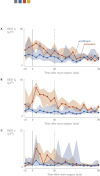Cerebral Oxygenation and Activity During Surgical Repair of Neonates With Congenital Diaphragmatic Hernia: A Center Comparison Analysis
- PMID: 34976902
- PMCID: PMC8718750
- DOI: 10.3389/fped.2021.798952
Cerebral Oxygenation and Activity During Surgical Repair of Neonates With Congenital Diaphragmatic Hernia: A Center Comparison Analysis
Abstract
Background and aim: Neonatal brain monitoring is increasingly used due to reports of brain injury perioperatively. Little is known about the effect of sedatives (midazolam) and anesthetics (sevoflurane) on cerebral oxygenation (rScO2) and cerebral activity. This study aims to determine these effects in the perioperative period. Methods: This is an observational, prospective study in two tertiary pediatric surgical centers. All neonates with a congenital diaphragmatic hernia received perioperative cerebral oxygenation and activity measurements. Patients were stratified based on intraoperatively administrated medication: the sevoflurane group (continuous sevoflurane, bolus fentanyl, bolus rocuronium) and the midazolam group (continuous midazolam, continuous fentanyl, and continuous vecuronium). Results: Intraoperatively, rScO2 was higher in the sevoflurane compared to the midazolam group (84%, IQR 77-95 vs. 65%, IQR 59-76, p = < 0.001), fractional tissue oxygen extraction was lower (14%, IQR 5-21 vs. 31%, IQR 29-40, p = < 0.001), the duration of hypoxia was shorter (2%, IQR 0.4-9.6 vs. 38.6%, IQR 4.9-70, p = 0.023), and cerebral activity decreased more: slow delta: 2.16 vs. 4.35 μV 2 (p = 0.0049), fast delta: 0.73 vs. 1.37 μV 2 (p = < 0.001). In the first 30 min of the surgical procedure, a 3-fold increase in fast delta (10.48-31.22 μV 2) and a 5-fold increase in gamma (1.42-7.58 μV 2) were observed in the midazolam group. Conclusion: Sevoflurane-based anesthesia resulted in increased cerebral oxygenation and decreased cerebral activity, suggesting adequate anesthesia. Midazolam-based anesthesia in neonates with a more severe CDH led to alarmingly low rScO2 values, below hypoxia threshold, and increased values of EEG power during the first 30 min of surgery. This might indicate conscious experience of pain. Integrating population-pharmacokinetic models and multimodal neuromonitoring are needed for personalized pharmacotherapy in these vulnerable patients. Trial Registration: https://www.trialregister.nl/trial/6972, identifier: NL6972.
Keywords: cerebral activity; cerebral oxygenation; midazolam; neonates; sevoflurane; surgery.
Copyright © 2021 Costerus, Hendrikx, IJsselmuiden, Zahn, Perez-Ortiz, Van Huffel, Flint, Caicedo, Wijnen, Wessel, de Graaff, Tibboel and Naulaers.
Conflict of interest statement
The authors declare that the research was conducted in the absence of any commercial or financial relationships that could be construed as a potential conflict of interest.
Figures




Similar articles
-
Neurocardiovascular coupling in congenital diaphragmatic hernia patients undergoing different types of surgical treatment.Eur J Anaesthesiol. 2022 Aug 1;39(8):662-672. doi: 10.1097/EJA.0000000000001642. Epub 2021 Dec 1. Eur J Anaesthesiol. 2022. PMID: 34860716 Free PMC article.
-
The effect of sevoflurane vs. TIVA on cerebral oxygen saturation during cardiopulmonary bypass--randomized trial.Adv Clin Exp Med. 2014 Nov-Dec;23(6):919-24. doi: 10.17219/acem/37339. Adv Clin Exp Med. 2014. PMID: 25618118 Clinical Trial.
-
Complications of sevoflurane-fentanyl versus midazolam-fentanyl anesthesia in pediatric cleft lip and palate surgery: a randomized comparison study.Int J Oral Maxillofac Surg. 2010 Jan;39(1):5-9. doi: 10.1016/j.ijom.2009.09.007. Epub 2009 Oct 24. Int J Oral Maxillofac Surg. 2010. PMID: 19854614 Clinical Trial.
-
Effects of surgical repair of congenital diaphragmatic hernia on cerebral hemodynamics evaluated by near-infrared spectroscopy.J Pediatr Surg. 2005 Nov;40(11):1748-52. doi: 10.1016/j.jpedsurg.2005.07.001. J Pediatr Surg. 2005. PMID: 16291164 Clinical Trial.
-
Monitoring Cerebral Oxygenation in Neonates: An Update.Front Pediatr. 2017 Mar 14;5:46. doi: 10.3389/fped.2017.00046. eCollection 2017. Front Pediatr. 2017. PMID: 28352624 Free PMC article. Review.
Cited by
-
The impact of intestinal atresia on educational and mental health outcomes in school-aged children: A case-control cohort study.Pediatr Surg Int. 2023 Jan 20;39(1):86. doi: 10.1007/s00383-022-05357-y. Pediatr Surg Int. 2023. PMID: 36662364
-
[Hemodynamic monitoring in pediatric anesthesia].Anaesthesiologie. 2022 Jun;71(6):417-425. doi: 10.1007/s00101-022-01125-8. Epub 2022 May 23. Anaesthesiologie. 2022. PMID: 35925144 Review. German.
-
Clinical impact of analgesic-sedative agents and peri-operative clinical status on white matter brain injury in preterm infants following surgical NEC.J Neonatal Perinatal Med. 2023;16(3):527-537. doi: 10.3233/NPM-230084. J Neonatal Perinatal Med. 2023. PMID: 37742664 Free PMC article.
-
Changes in the Term Neonatal Electroencephalogram with General Anesthesia: A Systematic Review with Narrative Synthesis.Anesthesiology. 2024 Oct 1;141(4):670-680. doi: 10.1097/ALN.0000000000005088. Anesthesiology. 2024. PMID: 38775960 Free PMC article.
References
LinkOut - more resources
Full Text Sources

